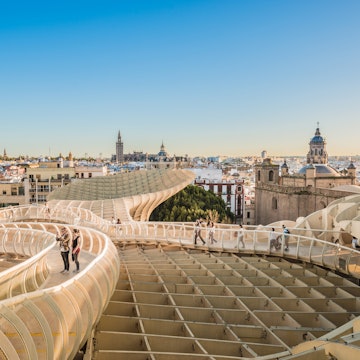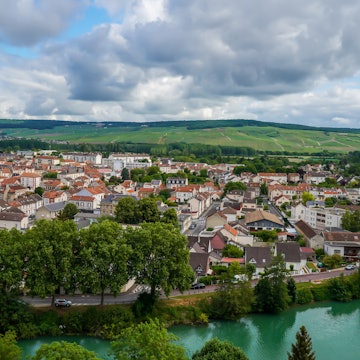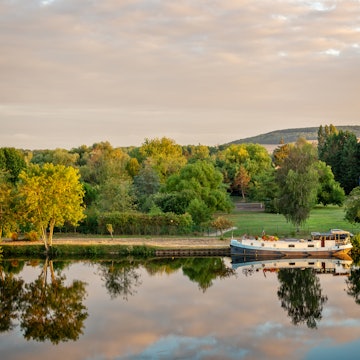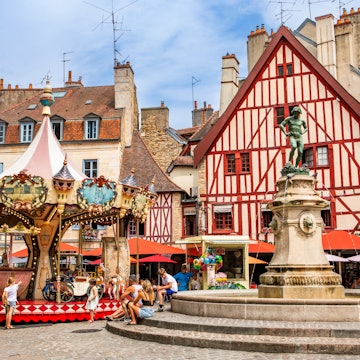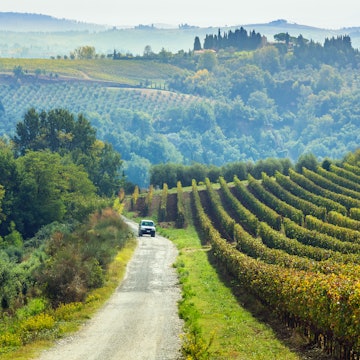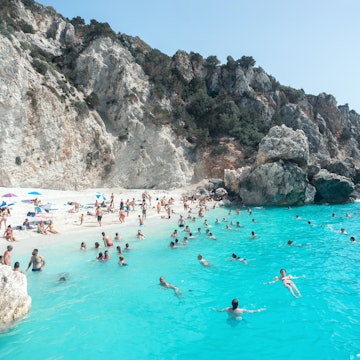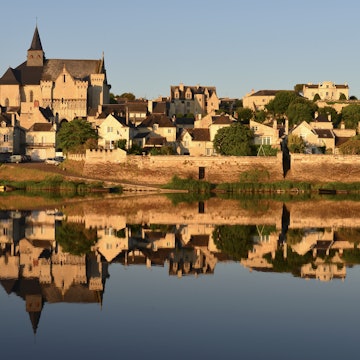
The best places to visit in Burgundy: art and culture paired with pinot noir

Nov 23, 2021 • 6 min read

Mooching around the streets of Dijon is a charming way to spend a day © Jon Lovette / Getty Images
Mention Burgundy – or Bourgogne as the French call this enticing chunk of la belle France – and whittling away hours sipping velvety reds and aromatic whites spring to mind. But there is far more to the nation’s premier wine-producing region than savoring prestigious vintages between vines or reveling in cloud wine over gourmet lunch pairings.
Handsome towns, Instagram-star medieval villages and ancient abbatial communities begging slow exploration pepper this predominantly rural region. To navigate Burgundy’s natural green labyrinth of emerald vineyards, shimmering mustard fields and dense dark forests, plug these ‘best places to visit’ into your device and hit go.
1. Explore Burgundy’s capital
Best city for art and architecture
Multi-colored patterned tiled roofs have been a status symbol in Burgundy since the 13th century and craning your neck upwards to gorge on the shiny tapestry of zig-zags. diamonds and other geometrical motifs crafted in ceramic-glazed terracotta is a Dijon highlight. Signature rooftops aside, the regional capital overflows with striking medieval and Renaissance architecture. Municipal museums offer free admission and one of France’s best fine-arts museums languishes inside the monumental Gothic-to-Classical palace where Charles the Bold and other Burgundy dukes partied in their heyday. For a city overview, scale the neighboring Tour Philippe Le Bon.
Visitors with a penchant for contemporary architecture, or food, or wine, or all three, won’t be able to resist Dijon’s ground-breaking Cité Internationale du Vin et de la Gastronomie (International City of Wine and Gastronomy), opening in a former 13th-century orphanage and later hospital in Spring 2022.

2. Be beau in Beaune
Best wine town
Burgundian wine culture seeps out of every handsome nook and cranny in Beaune, a celebrated wine town in the vineyard-carpeted Côte d’Or, even more beau (beautiful) than its name suggests. The centerpiece Hôtel-Dieu des Hospices de Beaune, created as a charity hospital in 1443, is a Gothic architectural masterpiece. Its dazzling polychrome tiled roof alone is enough to stop you in your tracks and drool, while some of the world's most expensive wines repose in its wine cellars.
The entire town feels like a living wine cellar in fact, with winetasting and cellar-tour options galore: the informative Maison des Climats is an excellent introduction. Watch for the much-anticipated opening of the Cité des Vins et de Climats de Bourgogne – split across wine towns Beaune, Chablis and Mâcon – in summer 2022. Beaune’s other ‘Don’t Miss!’ is a poke around Burgundy’s last remaining, family-run mustard maker where mustard seeds are milled by stone to make Real McCoy, Dijon AOP mustard.
3. Time-travel in Pays d’Axois
Best region for hilltop villages
West of Dijon, the picturesque towpaths of the Canal de Bourgogne meander into Pays d'Auxois. An unspoiled honeypot of uber-pretty hilltop villages, this rolling land of mustard fields and wooded hills begs a road trip – on foot, by bicycle, e-bike or four wheels. King of ‘les plus beaux villages’ (the most beautiful villages) is fortified hilltop Semur-en-Auxois, teetering on a granite spur in a hairpin bend of the meandering Armançon River. Châteauneuf-en-Auxois is another gorgeous spot to get lost in a cobweb of cobbled lanes laced with attractive houses.
Tucked into this verdant landscape is a twinset of exceptional historical sites: the tranquil, end-of-the-road Cistercian abbey of Fontenay (a Unesco World Heritage site no less) and the sensational MuséoParc Alésia, located on the very spot where Julius Caesar defeated Vercingétorix, chief of the Gauls, in 52 BCE.

4. Feel sweet in Flavigny
Best village for epicureans
Visiting the family-run Anis de Flavigny sweet factory in the quaint village of Flavigny-sur-Ozerain, a one-hour drive northeast of Dijon, is as much about lifting the lid on a centuries-old epicurean tradition as stuffing yourself silly with the hard-boiled, aniseed-flavored bonbons (sweets) for which the abbatial village is famed.
First crafted by Benedictine monks at 16th-century Abbaye de Flavigny in 1591, Les Anis de Flavigny still has its HQ at the abbey. The traditional sweet-making process, using natural ingredients (aniseed, beet sugar, plant extracts) remains unchanged. Fascinating guided visits explore the abbey’s Carolingian crypt and chapels, vaulted halls where the sweets were crafted in the 19th century, an interactive ‘laboratory of aromas’, and a museum displaying the sweet’s gorgeous trademark tins and packaging over the centuries. Tasting throughout is a given.
5. Catch the sunset in Noyers
Best village for a medieval vibe
Watching the sun sink below the medieval battlements of the multi-turreted, walled village of Noyers-sur-Surein, 30km (18.6mi) southeast of Auxerre, is pure romance à la française. Nineteen of its original 23 defensive towers from the 13th century still stand and the enchanting cobbled lanes, gabled houses and archways ensnared within its ancient stone ramparts are straight off a movie set.
Mooch between art galleries and artisan workshops selling handcrafted leather accessories or illuminated parchments penned in vintage quill. In July catch a music recital in the church. Lunch on traditional Burgundian coq au vin and jambon au Chablis (wine-infused ham) at Les Millésimes or vegetarian at La Vieille Tour. End on a natural high with a walk from outside the clock-topped southern gate to Noyers’ ruined hilltop chateau: the bird’s eye view of rolling pastureland, wooded hills and the River Serein dancing below is spectacular.
6. Go green in Morvan
Best park for outdoor action
When urban monuments and museums begin to exhaust, throw yourself into green Burgundy in its serene Parc Naturel Régional du Morvan. Brimming with flora, fauna and fantastic wildlife, this nature park is the place to take your foot off the pedal and slow right down in woodlands, lakes, farmland and frolicking hills. Begin in the main village, St-Brisson, where a scattering of small, well-considered eco-museums raise the curtain on local traditions, customs and landscapes.
The Maison du Parc in St-Brisson has all the gen on running wild in Morvan’s protected 3220 sq km (1243 sq mi). Hike, mountain bike, saddle up on horseback, try your hand at orienteering or fish for trout in the park’s smattering of lakes and rivers. Owl spotting tours after dark and boat trips on Lac des Settons are family favorites, as is a day out at the ancient Gaul-meets-modern-Burgundy, archeological site of Bibracte.
7. Get spiritual in Vézelay
Best village for mindful moments
Follow pilgrims to Vézelay, a honeypot hilltop village of teeny doll-house proportions and Unesco world heritage. One of the main routes to Santiago de Compostela in Spain begins on the steep cobbled lanes here and that first heady glance of medieval Basilique Ste-Madeleine teetering on a rocky spur is enough to reboot faith in the most jaded of souls.
To escape the crowds, hit the signposted trail hidden behind the basilica to Chapelle Ste-Croix, nicknamed 'La Cordelle' after the rope belts of Franciscan monks who adopted this spot in the 13th century. The beautiful stone chapel, cloaked in climbing grapevines, was built to commemorate Bernard de Clairvaux' preaching of the Second Crusade here in 1146. It is a sublime place today for peaceful meditation in the deep Burgundian countryside.
8. Find Colette in La Puisaye
Best region for literary heritage
French literature fans will enjoy the off-the-beaten-track journey in La Puisaye, a rural idyll of woods, winding creeks, canals and dark hills, 40 km (25mi) southwest of Auxerre. The area is best known as the birthplace of French writer Colette (1873–1954), author of La Maison de Claudine and Gigi and 50 other novels. Much of her work explores her rural Burgundian childhood, beautifully evoked in the Musée Colette, at home – as the enviably stylish French do so effortlessly well – in the village chateau in St-Saveur-en-Puisaye.
While you’re here, it would be remiss not to nip 7 km (4.3mi) south to Chantier Médiéval de Guédelon, an intriguing building site where artisans are rebuilding – as one does – a fortified castle using only 13th-century building techniques.
You may also like:
The best free things to do in Burgundy: beauté on a budget
Why you should follow Burgundy's Route des Grands Crus
France’s 10 most stunning road trips







